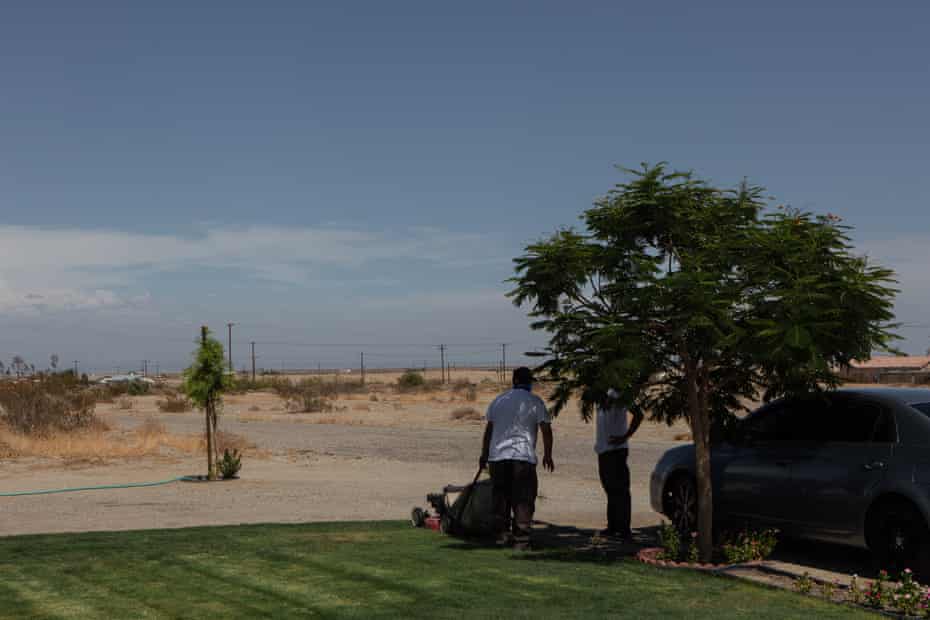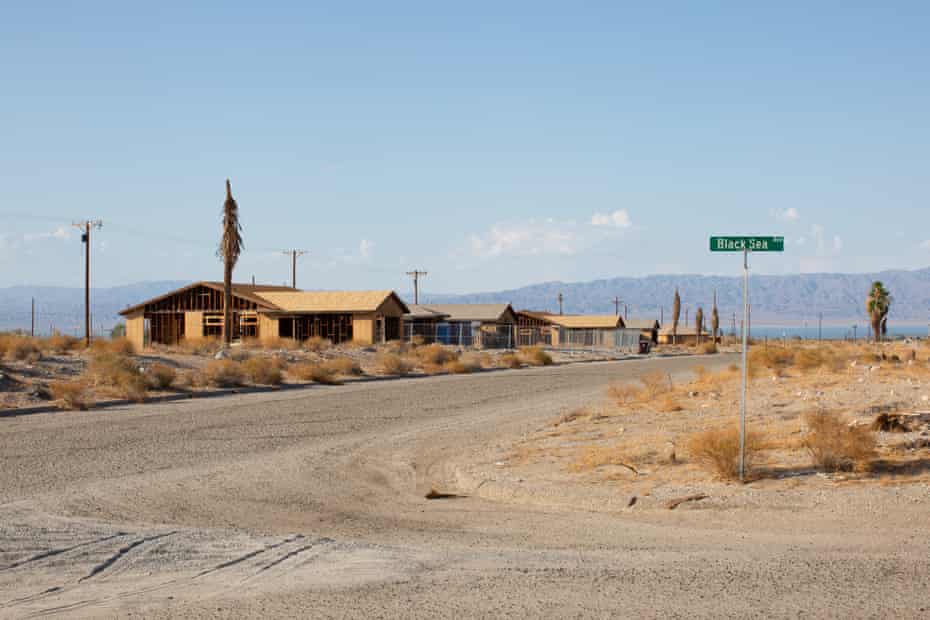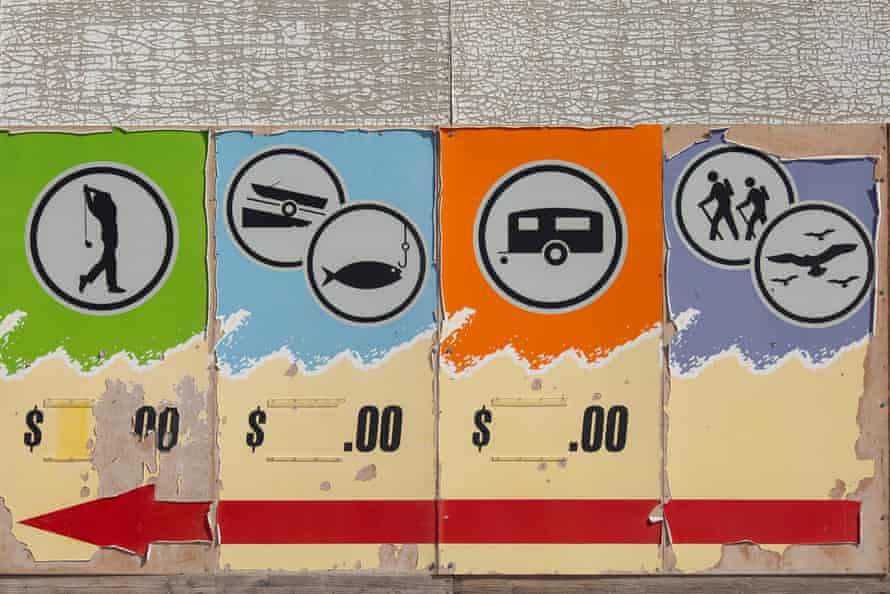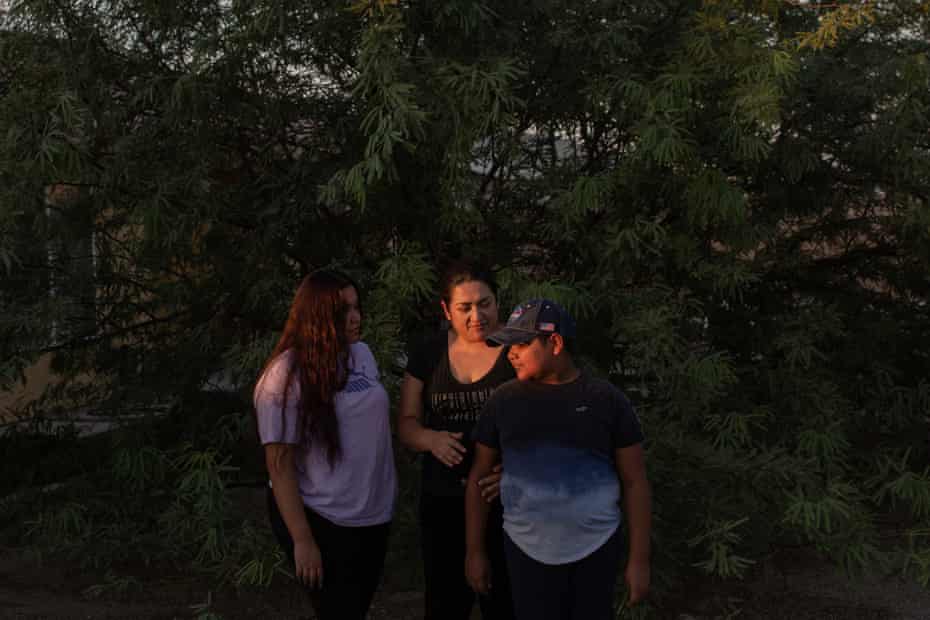The shrinking Salton Sea was once a tourist destination. Now it’s home to dangerous algal blooms, endless dust and noxious air
Just to be safe, Noemi Vazquez keeps inhalers in almost every room of her house. She stashes them in her kitchen cupboard, a couple in her purse, one in the bathroom, and, of course, by her bedside.
And then there’s the large, black Puma knapsack where she keeps her nebulizer, several inhalers, and the montelukast pills she takes to treat her wheezing. Her four-year-old granddaughter has her own asthma kit – a neon pink and purple Trolls-themed lunch box that holds a small, child-sized nebulizer and a few inhalers. “She’s smart! She knows: this is her bag,” Vazquez said.

Asthma and allergies are a part of life here in Imperial county, California. A way of life, even, in a region shrouded by a grey-beige dust that haunts Vazquez’ days and nightmares. A few years ago, when the air was particularly thick, she awoke in the night unable to speak or breathe. Her skin was purple. “If my husband wasn’t sleeping next to me that night, I would have passed away,” she said. “I think about all those people who don’t have anyone sleeping next to them. About the kids who don’t know how to talk yet.”
Here, in California’s far south-east, there’s no escaping the noxious air. The haze that hovers over Imperial is a peculiar blend – incorporating pesticide plumes, exhaust fumes, factory emissions, and something curious: vaporized dust rising from the nearby Salton Sea.
The glimmering blue basin that stretches across the desert is either starkly beautiful or grotesque – depending on whom you ask. Formed more than a century ago by a breached canal, the Salton Sea is many things. It is California’s largest lake, an ecological oasis, a former mecca for famous vacationers, and a muddy sink for agricultural runoff. For decades, it has been shrinking, exposing a powdery arsenic-, selenium- and DDT-laced shoreline that wafts into the atmosphere.
Near the sea, hospitalization rates for children with asthma are double the state average, and one in five kids have the condition. Many of the mostly Mexican American farm workers and outdoor laborers who live and work in Imperial, one of the state’s poorest counties, breathe in a dangerous mix of Salton Sea dust and pesticide on a daily basis as well. In Calipatria, Brawley and Westmorland and other towns around the lake, adult asthma rates are among the highest in the state.
It can be a punishing place to live, said Amor Garcia, 31, who moved to the area four years ago. “No one warned us it would be so bad for our health,” she said. On muggy mid-summer days, temperatures here creep up to 120F and the desert streams with a brown vapor. The hot, grimy air clings to hair and creeps under fingernails. The sea steams up a sulfurous stench.


Garcia worries that in the coming years, if nothing is done to address the pollution crisis, the area will become almost unlivable. An unprecedented drought amplified by the climate crisis and growing demand for water in southern California are both hastening the Salton Sea’s decline. Researchers predict that the sea could lose nearly three quarters of its volume by 2030. By some estimates, the declining water level could expose an additional 1000,000 acres of playa.
“All that dust that gets exposed would mean even more breathing problems and more allergies and asthma for the people who live here,” said Shohreh Farzan, an environmental epidemiologist at the University of Southern California who has been analyzing how the dust around the Salton Sea is affecting children.
A resort for celebrities and presidents
The Salton Sea was formed in 1905 when the Colorado River breached an irrigation canal and filled up an ancient basin in the desert, creating an oasis for migratory shorebirds and, by the middle of the 20th century, for celebrities and dignitaries. Developers dotted the shores with palm trees and built up luxury resorts around its perimeter, and the area became a destination for Frank Sinatra, Bing Crosby and the Beach Boys. President Dwight Eisenhower used to come by the golf course.
Working class families like Steve Johnson’s would also come and visit. His grandfather bought a small property by the beach, and as a kid Johnson would fish and swim in the lake during his summer vacations. “We didn’t really mingle with the celebrities – though Zeppo Marx, of the Marx Brothers, I did meet once,” Johnson, 59, recalls, as he nurses a Miller High Life at the Ski Inn, the best – and only – dive bar in Bombay Beach, a once-bustling vacation community by the sea that now houses a handful of mostly artists and anarchists. He moved here two decades ago. “It is just beautiful,” he said. And then he paused. “Well. It’s complicated.”
Johnson still swims in the lake sometimes – but nowadays he’s an exception. After the breached canal that created the lake was mended, it was mostly sustained by runoff water from nearby farms – water that was full of pesticides and nitrates, which blended with salt deposits in the lake bed to create an increasingly salty sea. By the 1990s, the sea had started getting even smaller, and saltier, killing off masses of fish and birthing noxious algal blooms. Over the past few decades, tens of thousands of migratory birds around the lake have died of either starvation or poisoning.
“And then came the odor,” said Miriam Juarez, 37, who has lived near the sea for most of her life. “It’s repugnant.” Her parents used to take her and her brothers to fish in the sea as well, she said. But her kids have only ever known the lake as a toxic void that periodically spews up fish bones and poison dust. On a searing summer day, as the mercury crept past 120F (48.9C), Juarez’s kids huddled into their air-conditioned bedrooms, her eight-year-old son occasionally popping out to grab a popsicle from the freezer. It’s often too hot and too dusty to play outside – so many local kids opt to get their exercise at the Crossfit gym nearby.
For many families – including Juarez’s – the pandemic has been especially traumatizing. Imperial county has been one of the hardest hit regions in California, and the residents’ high rates of respiratory issues has made them especially vulnerable to complications from Covid-19. But it has come with a small silver lining for some: staying indoors and wearing masks for the past year and a half has ameliorated asthma and allergies. “We’re probably going to keep our masks on, even after the pandemic,” Juarez said. “To wear against the dust.”
The masks will be one more addition to the elaborate rituals the Juarez and others have adopted to survive in this dusty valley. She never opens her windows and stuffs towels under the doors of her home in Salton City, just west of the lake. Her kids’ schools have a system of raising green, yellow and red flags to indicate how bad the air pollution is on a given day – but even on so-called good days, many of the kids at her youngest daughter’s schools stay indoors for recess, to avoid aggravating their asthma.
Vazquez, 52, who runs her daycare out of her home, switches out her air filters every week, mops a few times a day, and requests that visitors wear disposable shoe covers – the kind they use in sterile operating rooms – to avoid tracking in dust. Out of the 10 or so kids currently under Vazquez’s charge, five use inhalers for asthma. Over the years she’s seen some really severe cases: kids that could hardly go outside without getting winded, two- or three-year-olds who couldn’t stop wheezing. Most children come to daycare carrying their own medical bags stocked with inhalers, creams and pills for allergies, saline nasal sprays for perpetually blocked noses and a change of clothes in case of nosebleeds, which kids in this neighborhood get constantly.
Seven-year-old Derek, whom Vazquez watched when he was a toddler, had it so bad he was constantly in and out of the hospital and urgent care. He was born prematurely, his lungs a bit underdeveloped, his mother, Melissa Fischer, said. She still has videos on her cellphone from the various times he was hospitalized as a baby and toddler – he’d be hooked up to an IV, and she’d sing to him to keep him calm and cheer him up. He’s doing better these days; he still wheezes on windy days, but his inhaler usually fixes him up.

“I don’t think he remembers being in the hospital,” said Fischer. “But I think it was traumatic.” He’s always exceptionally cautious about new places and experiences, Fischer said, looking over as her son played on the couch. “I think it instilled a fear in him.”
Generations have been harmed and traumatized by the pollution, Vazquez said. She, her 27-year-old-daughter and her four-year-old granddaughter all have severe asthma. The dust has been making generation after generation sick, she said. “And hardly anything has changed.”
A string of broken promises
In 2003, the local water authority in the region signed the largest agriculture-to-urban water transfer agreement in US history with San Diego. Imperial Irrigation District (IID) agreed to start selling much of its massive allotment of water from the Colorado River to city-dwellers and suburbanites along the coast. As part of the deal, IID agreed to send some water to the Salton Sea for 15 more years, buying it and other local authorities time to find a solution for the shrinking lake.
“And for 15 years, everyone just sat there and did a lot of nothing,” said Luis Olmedo, executive director of Comite Civico Del Valle, a health and social services organization in Brawley, just south of the Salton Sea. A $8.9bn proposal in 2007 to rehabilitate the lake fell through as the Great Recession took hold. In 2015, local authorities broke ground on a project at Red Hill Bay, intending to flood the desiccated lakebed to the south of the lake with water from the sea and the nearby Alamo River, to keep down the dust and create wetlands for birds. Today, it remains flat, dry and dusty – the project has been derailed by budget issues, local politics and “just a lack of will”, said Olmedo. “They keep doing these ribbon-cutting ceremonies, and nothing happens.”
A dust-coated sign staked at the Red Hill site still optimistically promises: “Estimated construction in 2016.”


And still, consulting companies, advocacy groups and local officials have been dreaming up bigger, more creative plans to solve the problem. One idea was to pipe in water from the Sea of Cortez, desalinate it and pump it into the lake. Some local residents have wondered: why not pipe in water from the Pacific? “I mean, maybe that’s wild, but why not?” said Johnson. “We have to try something.”
In recent years, the state’s energy commission has become increasingly interested in the prospect of investing in lithium extraction from the area. It has doled out millions to energy companies to explore mining the element used in the batteries that power cellphones and electrical cars. If one small-scale demonstration plant being developed by a subsidiary of Berkshire Hathaway Energy goes well, the company envisions that the Salton Sea region could produce a third of the world’s lithium, revive the region’s stalling economy and rev up the country’s ambitious plans to decarbonize transportation.
“It’s all just speculation,” sighs Olmedo, shaking his head at the oozing mud pots near one of the region’s existing geothermal energy plants. “While various companies are biding their time waiting for this lithium thing to take off, where does it leave the community? We’re still breathing the toxic air.”
Robert Schettler, a spokesperson for the irrigation district, said: “At IID, we, too, are frustrated with the progress at the Salton Sea, but we continue to work on things there.” The water agency’s leaders have pointed to various dust suppression projects they’ve undertaken in recent years, including planting vegetation to tamp the soil down and “surface roughening” – basically, digging ridges in the dried mud to break the wind and keep the playa from flying up.
The state has also started up a $206m project to restore habitat for fish and birds at the south-west edge of the lake. “Make no mistake, this is a challenging endeavor,” said Arturo Delgado, the assistant secretary for Salton Sea policy at the California Natural Resources Agency. But, he said in a statement to the Guardian, “progress is happening”.
Nancy del Castillo, 42, who lives with her husband and two kids in Salton City, said she had trouble trusting such reassurances. She’s been trying to save up for years to move to a different neighborhood, with better air. There’s still pollution from pesticides, and from diesel fumes up in Riverside and Coachella, to the north – but it’s not as bad.

“The earth has been raising toxic dust for years,” she said. “It seems ugly to me that officials keep deceiving people, telling us they’re going to fix it.”
Castillo and a group of her neighbors have been faithfully attending community meetings, local hearings and even bigger meetings on how to improve the Salton Sea situation for years, she said, and have grown increasingly frustrated.
Once, after she spoke about the air pollution in Imperial county at a meeting in Sacramento, California’s capital, Castillo said, she overheard a man dismiss the crisis: “Yeah, but there’s just a few people living there.” Many families in the region are Mexican immigrants, she said, people who work in the fields or in construction, who can’t afford to move somewhere else, who breathe the toxic air because they have no other choice. But to this man, she said, “it’s like we don’t even count”.
Meanwhile, many local residents worry that time is running out. “With more climate change and more desertification and drought,” the environmental and health issues are going to keep getting worse, said Ryan Sinclair, a professor of public health at Loma Linda University who has been mapping the sea’s decline. The current, unprecedented drought gripping the western US has only put more pressure on the shrinking Colorado River, which feeds thirty farms and cities up and down the region, further complicating the calculus and politics of how and where to send its waning waters. By 2045, researchers estimate that the sea could someday become 10 times as salty as the Pacific Ocean, making it completely uninhabitable for fish. Its receding shores could expose nearby communities to as much as 100 tons of dust each day.
Versions of the same apocalyptic vision are unfolding across the world. Utah’s Great Salt Lake has been shrinking and spitting up arsenic as well. Iran’s Lake Urmia is just about 10% of its original size. The ecological crisis at Kazakhstan’s diminished Aral Sea has become a perverse tourist attraction.

“Still, I don’t want to leave here,” said Juarez. “I want to stay. I want to fight.” Her kids do, as well. She brings out a folder full of drawings and letters that her younger kids and their friends made at school. Her daughter Lisette’s appeal to local officials included a drawing of a stick figure in goggles swimming in the lake, while another stick figure lounges by the shore, under a striped umbrella, sipping a cold beverage. “Dear Sir or Madam, please help us save the Salton Sea,” she wrote above the picture. “Thank you!”